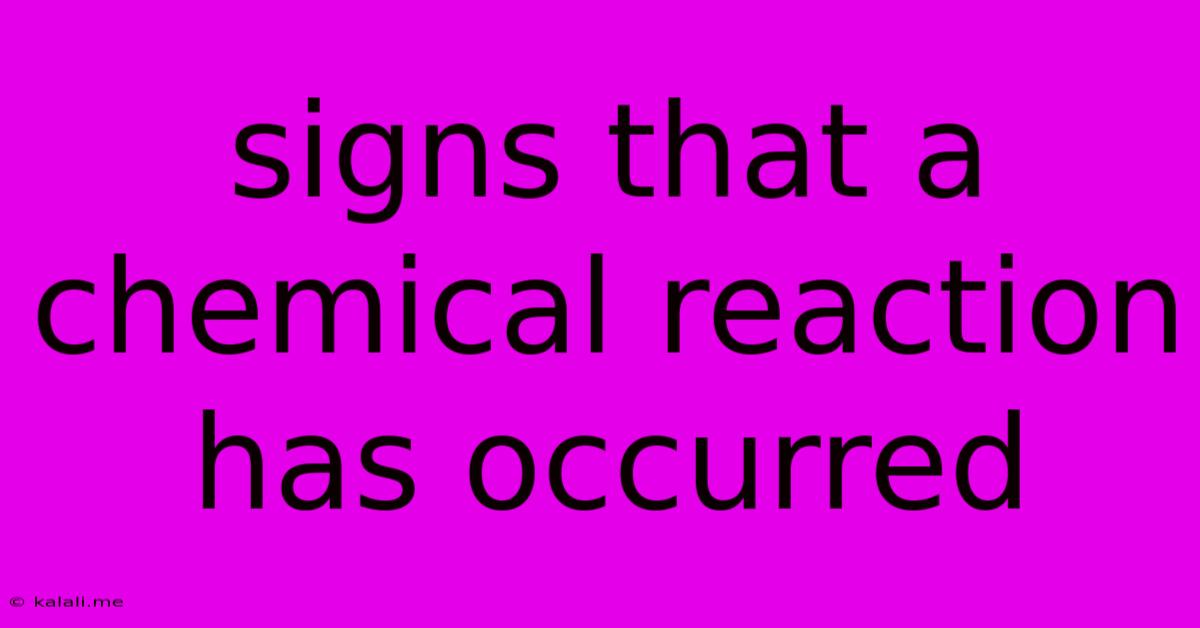Signs That A Chemical Reaction Has Occurred
Kalali
May 09, 2025 · 3 min read

Table of Contents
Signs That a Chemical Reaction Has Occurred: A Comprehensive Guide
Meta Description: Learn to identify chemical reactions! This guide explores key observable changes – like temperature shifts, gas production, color changes, and precipitate formation – that signal a chemical transformation has taken place. Understand the science behind these indicators and improve your chemistry skills.
Chemical reactions are the fundamental processes that govern the world around us. From the digestion of food to the rusting of iron, chemical changes are constantly occurring. But how do we know when a chemical reaction has actually taken place? While some reactions are subtle, many display clear, observable signs. This guide will delve into the most common indicators that a chemical reaction has occurred.
1. Temperature Change (Exothermic and Endothermic Reactions)
One of the most readily apparent signs of a chemical reaction is a change in temperature. Reactions that release heat are called exothermic reactions. You'll often feel the container warming up. Examples include combustion (like burning wood) and neutralization reactions (mixing an acid and a base). Conversely, reactions that absorb heat are endothermic reactions. These reactions will cause a decrease in temperature, making the container feel colder. Dissolving certain salts in water is a classic example of an endothermic reaction. The change in temperature reflects the energy changes associated with the breaking and forming of chemical bonds during the reaction.
2. Gas Production (Effervescence)
The production of gas is another strong indicator of a chemical reaction. This is often observed as effervescence, or bubbling. The gas produced can be easily identified sometimes by its smell (e.g., hydrogen sulfide's characteristic rotten egg odor) or by its reaction with other substances. Many reactions involving acids and carbonates produce carbon dioxide gas, which can be detected using limewater. This visible bubbling confirms a chemical change has happened, altering the original substances' chemical makeup.
3. Color Change
A change in color often suggests a chemical reaction. This is because the reactants and products have different electronic structures, leading to the absorption and emission of different wavelengths of light, thus resulting in a visible color change. For example, the browning of an apple after it’s cut is a result of enzymatic oxidation, resulting in a clear color transformation. The change isn't just a physical change; it's a chemical alteration of the apple's compounds.
4. Precipitate Formation
The formation of a precipitate – a solid that separates from a solution – is a clear sign that a new substance has been formed through a chemical reaction. This occurs when two soluble substances react to produce an insoluble product. The precipitate often appears as a cloudy or solid substance settling at the bottom of the container, significantly altering the solution's appearance. This formation of a new, insoluble solid is definitive proof of a chemical reaction taking place.
5. Light Emission
Some chemical reactions produce light, a phenomenon known as chemiluminescence. This is a spectacular demonstration of a chemical reaction, indicating a significant energy change. Examples include the glow sticks that produce light through a chemical reaction, or the burning of magnesium ribbon which emits a bright, white light. This light emission is a direct result of the energy released during the chemical process.
6. Odor Change
A change in odor can also signal a chemical reaction. The formation of new substances often leads to the release of volatile compounds with distinct smells. For instance, the sour smell of vinegar (acetic acid) indicates that a chemical reaction has taken place. This is different from a physical change; the substance itself has chemically transformed. The new odor is a product of the reaction.
Conclusion: Recognizing Chemical Transformations
Observing these signs – temperature changes, gas production, color shifts, precipitate formation, light emission, and odor changes – provides strong evidence that a chemical reaction has occurred. While not every chemical reaction will exhibit all of these signs, the presence of one or more is a clear indication that a transformation of matter has taken place at the molecular level. Understanding these indicators is key to appreciating the dynamic nature of chemistry and the constant chemical processes shaping our world.
Latest Posts
Latest Posts
-
How Much Is 50 Fl Oz
May 09, 2025
-
What Is The Least Common Multiple Of 4 And 14
May 09, 2025
-
How Many Inches Is 3 3 Ft
May 09, 2025
-
How Much Is 3 5 Grams In An Ounce
May 09, 2025
-
How Many Hours Is 124 Minutes
May 09, 2025
Related Post
Thank you for visiting our website which covers about Signs That A Chemical Reaction Has Occurred . We hope the information provided has been useful to you. Feel free to contact us if you have any questions or need further assistance. See you next time and don't miss to bookmark.